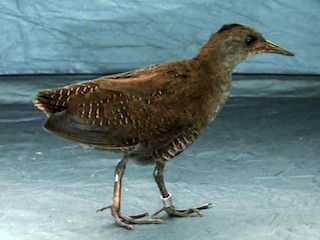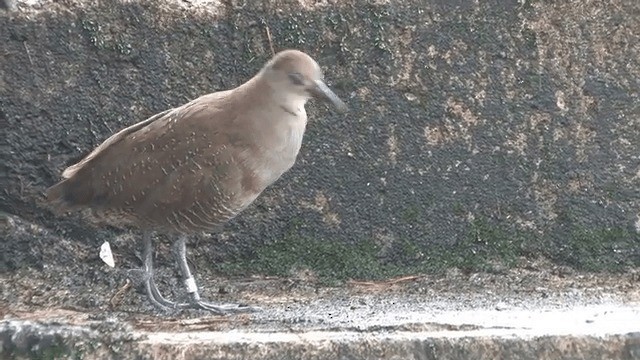Luzon Rail Lewinia mirifica Scientific name definitions
- DD Data Deficient
- Names (23)
- Monotypic
Text last updated December 30, 2016
Sign in to see your badges
Species names in all available languages
| Language | Common name |
|---|---|
| Bulgarian | Лусонски дърдавец |
| Catalan | rascló de Luzon |
| Croatian | luzonska kokošica |
| Czech | chřástal hnědopásý |
| Dutch | Luzonral |
| English | Luzon Rail |
| English (United States) | Luzon Rail |
| Estonian | luzoni väikeruik |
| Finnish | luzoninluhtakana |
| French | Râle de Luçon |
| French (Canada) | Râle de Luçon |
| German | Luzonralle |
| Japanese | ルソンクイナ |
| Norwegian | luzonrikse |
| Polish | wodnik luzoński |
| Russian | Лузонский пастушок |
| Serbian | Luzonski petlovan |
| Slovak | chriašteľ luzonský |
| Spanish | Rascón de Luzón |
| Spanish (Spain) | Rascón de Luzón |
| Swedish | luzonrall |
| Turkish | Luzon Sukılavuzu |
| Ukrainian | Левинія лусонська |
Lewinia mirifica (Parkes & Amadon, 1959)
Definitions
- LEWINIA
- mirifica / mirificus
The Key to Scientific Names
Legend Overview
Field Identification
20–23 cm. Sexes alike. Differs from L. pectoralis in absence of black streaks on less brightly coloured head and hindneck , whiter throat and lack of prominent barring on upperwings. Distinguished from sympatric Gallirallus species by smaller size, and by relative extent of pale markings on upperparts and barring on underparts; from sympatric Zapornia species by longer bill, rufous crown and nape, and pattern of upperparts. Immature duller than adult: dark greyish brown on crown and hindneck, and greyer on cheeks and upper breast; bill darker than that of adult. Juvenile undescribed.
Systematics History
Subspecies
Distribution
Luzon, in N Philippines.
Habitat
Precise habitat unknown, but species recorded from wet grassy areas; unlike congeners, may have strict ecological requirements. Older (20th century) records are from mountain foothills, with migrating birds being recorded at altitude of c. 1000 m. Five more recent specimens are from 1080 m, 1413 m, 2530 m and 2690 m (two specimens) with a (contested (1) ) photograph from 2240 m (2).
Movement
In 1965–1970, total of 191 birds ringed at Dalton Pass in May–Jun and Oct–Dec, apparently while undertaking post-breeding dispersal or intra-island migration, the latter possibly between Cagayan Valley and Central Plain or between Sierra Madre and Cordillera Central. Also recorded elsewhere in mountain foothills in Dec–Jan.
Diet and Foraging
Sounds and Vocal Behavior
Presumed contact calls are very short squeaks, lasting 0·15–0·30 seconds and starting and stopping quite abruptly (1). No other information.
Breeding
Conservation Status
Not globally threatened. Currently considered Data Deficient. Restricted-range species: present in Luzon EBA. Recorded only from Luzon, where known from records of migrating birds at Dalton Pass in Sierra Madre Mts, and from at least six other localities in Nueva Écija, Nueva Vizcaya, Camarines Norte, Benguet and Mountain Provinces. Described as uncommon, but secretive habits may obscure true status; the significant numbers formerly trapped on migration suggest that the species may have been more numerous. Nevertheless, paucity of known localities, and scarcity of records in last few decades, have been interpreted as evidence that the species is becoming increasingly rare. Post-1972 records include one found dead at the roadside in Baguio in 1979 (3), an unspecified number between Bamban and Camp O’Donnell in Jun 1993 (3), one photographed on Mt Data in Jan 2001 (2) (although the photograph has been questioned (1) ), one specimen from Mt Labo in May 2006, three from Mt Amnyao in Mar 2007 and one near Mt Pinatubo, Mar 2012 (1). In Nov 2009, 10 individuals were recorded as they were caught by bird-trappers at Dalton Pass (1). The only known threat is hunting, but its effects have not been quantified. Listed as Endangered until 2000, there are few recent records and almost nothing known of its distribution, population, ecology and threats, thus an assessment of its threat status is currently not possible BirdLife International (2015) Species factsheet: Lewinia mirifica. Downloaded from http://www.birdlife.org on 13/10/2015. .

- Year-round
- Migration
- Breeding
- Non-Breeding












































